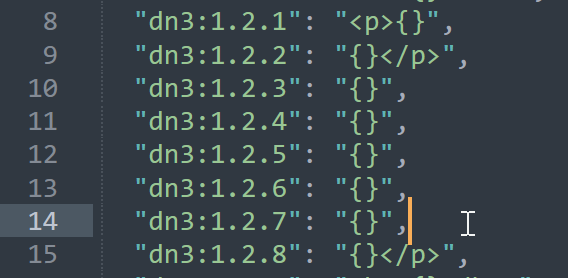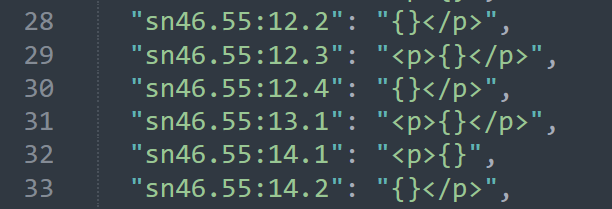yes, there should always be a wrapper, which must be:
p, hx, li, dd, dt
yes, there should always be a wrapper, which must be:
p, hx, li, dd, dt
The phrase Tamenaṁ gijjhāpi kākāpi kulalāpi anupatitvā anupatitvā vitacchenti virājenti occurs in many Suttas of the 19th Saṁyutta.
In most cases, it is translated “Vultures, crows, and hawks kept chasing it (him, her), pecking and clawing”, while in a few it is “Vultures, crows, and hawks kept chasing him, pecking, plucking, and hacking”. In SN 19.1, there’s the extra term phāsuḷantarikāhi which is not translated.
In SN22.1 Nakulapitusutta
"May the Buddha please advise meand instruct me. It will be for my lasting welfare and happiness.”
should be me and
It seems the extra verb vituḍenti is used along with phāsuḷantarikāhi, i.e. “stabbing in the ribs”. In the parallel Vinaya passage, this is the only verb, whereas here all three are used. There are multiple variants all over, though, so best not get too attached!
- Tamenaṁ gijjhāpi kākāpi kulalāpi anupatitvā anupatitvā phāsuḷantarikāhi vitudenti vitacchenti virājenti.*
Vultures, crows, and hawks kept chasing it, pecking, clawing, and stabbing it in the ribs.
Thanks for spotting this. It’s a bug due to a recent change in how we deal with spaces. We’ll fix it!
FYI: MN4
Just happened to be reading the Sutta Central hardcopy 1st edition 2021 [HC] and discrepancy is found when compared with with the Sutta Central website [SC].
[HC] hard to find joy in it.
[SC] hard to find in solitude.
[pāli] durabhiramaṁ ekatte
A word appears to be missing in SC.
You’re right, thanks:
It’s hard to maintain seclusion and hard to find joy in solitude
Yes, exactly, as it is a skeleton, the ribs suggest themselves for the stabbing. And thanks, I’ve missed the extra verb vitudenti.
I also learned from your post how to do this impressive highlighting! ![]()
The German translator, Ven. Nyanaponika, has of all this Saṁyutta only translated the first Sutta, as well as the 17th about the bad monk, because he found them too grotesque and disgusting to translate; no mention of ribs there in SN 19.1.
This is about AN1.394-574 & AN1.575-627.
When seen all together in the view I have linked, it is apparent that each individual sutta differs slightly from the next in the series.
However, if browsing the individual suttas, eg, AN1.394, AN1.395… each sutta is an exact replica of the first of the series. The differences are missing.
Oh yes, there’s definitely a bug there. The individual texts also have a bit of stray extra text at the end. We’ll fix it!
Huh, interesting.
Thanks, “heavenly realm”.
Translated by Ayya Soma but the publication data is wrong. Maybe this is something @carmi works on?
Thank you for finding this! The source URL also goes to sujato, not to soma. As Voice looks at _publication.json, we have been struggling with this issue for quite a while, with no success. Because we haven’t seen the root of the problem!
Thanks @Snowbird I’ll need to check with Hongda. Not sure why those publication details are being displayed. Ayya Soma’s publication details are available.
This is indeed strange.
Meanwhile Karl managed to fix the problem on our side, and it will be working on Voice in due time … that is, some months. ![]()
![]()
![]()
SN20.10:1.2: Tena kho pana samayena aññataro bhikkhu ativelaṁ kulesu cārittaṁ āpajjati.
Now at that time a certain junior mendicant socialized with families too often.
He isn’t junior; just a certain mendicant. (Probably this has been mistakenly copied from the previous Sutta, where it is indeed a junior mendicant.)
Is there a reason why at the end of some Therigatha verses there is an elipses only segment in the Pali?

It produces some odd results, even on the SC website…
Bhante Sujato:
There’s this term ahaṅkāramamaṅkāra. Sometimes it is translated as “ego and possessiveness”, and sometimes as “I-making and mine-making”.
In DN 10:2.27.3 there are “clay drums” and “clay-drums” even in the same segment. The same in DN 2:90.1.
SN40.2:1.1: “‘Dutiyaṁ jhānaṁ, dutiyaṁ jhānan’ti vuccati.
“They speak of this thing called the ‘second absorption’.
SN40.2:1.2: Katamaṁ nu kho dutiyaṁ jhānanti?
What is the second absorption?”
SN40.2:1.3: Tassa mayhaṁ, āvuso, etadahosi:
It occurred to me:
Here and in the following Suttas we have a confusing situation with the quote marks. The Sutta starts out with Moggallana quoting his own thought, and the introductory part is left out. The Pali has a double plus single quote mark at the start, the English just the double.
There should probably be no closing quote mark in translation at the end of segment 1.2, as Moggallana continues speaking; or else segment 1.1 should start with double plus single quote mark, and at the end of segment 1.2 there should be a single closing quote mark (and in that case “second absorption” be set in double quotes). ![]()
Think I found another uncontained segment:

There is a closing p tag, but the opening in missing in dn3:1.2.3

sn46.55.12.4 is missing an opening <p>

sn46.130:1.9 missing opening and closing

iti78:2.3 should be wrapped in p
This one really stumped me:
an1.454:1.1 doesn’t have a {} in it. I think that’s a no-no, eh?
Just an FYI, I found these by hiding all the text in the document that was inside p and ol tags but not hiding h tags. Then i just visually scanned the results. I checked DN, MN, SN, AN, Dhp, Ud, Iti, Snp, Thag, and Thig.
Blurb to SN 21.2:
Sāriputta says that there is nothing whose change, even the Buddha, would cause him sorrow.
This sentence sounds strange to me.
Maybe: “there is nothing, even the Buddha, whose change would cause him sorrow”.
vipariṇāmaññathābhāvā is sometimes translated as “decay and perish”, sometimes as “change and perish”.
AN7.56:1.3: Atha kho dve devatā abhikkantāya rattiyā abhikkantavaṇṇā kevalakappaṁ gijjhakūṭaṁ obhāsetvā yena bhagavā tenupasaṅkamiṁsu; upasaṅkamitvā bhagavantaṁ abhivādetvā ekamantaṁ aṭṭhaṁsu. Ekamantaṁ ṭhitā kho ekā devatā bhagavantaṁ etadavoca:
Then, late at night, a glorious deity, lighting up the entire Vulture’s Peak, went up to the Buddha, bowed, stood to one side, and said to him,
There are two deities visiting the Buddha, not one … this has also implications in other segments.
SN1.38:2.1: Atha kho sattasatā satullapakāyikā devatāyo abhikkantāya rattiyā abhikkantavaṇṇā kevalakappaṁ maddakucchiṁ obhāsetvā yena bhagavā tenupasaṅkamiṁsu; upasaṅkamitvā bhagavantaṁ abhivādetvā ekamantaṁ aṭṭhaṁsu.
Then, late at night, several glorious deities of the Satullapa Group, lighting up the entire Maddakucchi, went up to the Buddha, bowed, and stood to one side.
It’s “seven hundred”, not “several”. (Although it’s only seven who speak.)
In AN 9.3 and Ud 4.1, kulaputta has been translated as “kinsman” and not, as usually, “gentleman”.